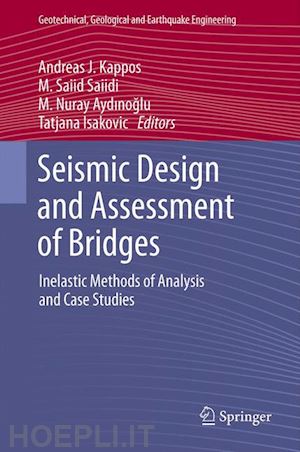
Questo prodotto usufruisce delle SPEDIZIONI GRATIS
selezionando l'opzione Corriere Veloce in fase di ordine.
Pagabile anche con Carta della cultura giovani e del merito, 18App Bonus Cultura e Carta del Docente
Preface
Contributors
1 Introduction
Andreas J. Kappos
2 Modelling of Bridges for Inelastic Analysis
M. Saiid Saiidi, Antonio Arêde, Donatello Cardone, Pedro Delgado, Mauro Dolce, Matej Fischinger, Tatjana Isakovic, Stavroula Pantazopoulou, Gokhan Pekcan, Rui Pinho, and Anastasios Sextos
2.1 Introduction
2.2 Superstructure (Deck)
2.2.1 Deck Types, Sectional Layouts and Properties
2.2.2 The Role of Deck Modelling in Seismic Assessment
2.2.3 Effects of Skew and Curvature in Plan
2.2.4 Verification of Deck Deformation Demands
2.3 Bearings and Shear Keys
2.3.1 Modelling of Bearings
2.3.2 Mechanical Bearings (Steel Bearings)
2.3.3 Modern Bearing Types
2.3.4 Modelling of Shear Keys
2.4 Isolation and Energy Dissipation Devices
2.5 Piers
2.5.1 Modelling for Seismic Response of Columns in Reinforced Concrete Bridges
2.5.2 Finite Length Plastic Hinge Model
2.5.3 Distributed Flexibility Based Element Model
2.5.4 Two and Three-Dimensional FEM Discretizations
2.5.5 Example 1 on Fiber Model Application
2.5.6 Example 2 on Fiber Model Application
2.5.7 Analytical Modelling of Hollow Box Columns
2.6 Modelling of dynamic interaction between piers, foundation and soil
2.6.1 Pseudo-static Winkler approach
2.6.2 Linear Soil-Foundation-Bridge Interaction Analysis in the Time Domain
2.6.3 Nonlinear Soil-Foundation-Bridge Interaction Analysis in the Time Domain
2.7 Modelling of Abutment-Embankment-Superstructure Interaction
2.7.1 Simple P-y Relationships for Modelling Embankment-abutment Systems
2.7.2 Typical Bridges Studied
2.7.3 Modelling of the Abutment-Foundation-Backfill-Embankment Systems
2.7.4 Proposed P-y Relationships for Typical Abutment-Embankment Systems and Comparison with Caltrans Guidelines
3 Methods for Inelastic Analysis of Bridges
M. Nuray Aydinoglu, Matej Fischinger, Tatjana Isakovic, Andreas J. Kappos, and Rui Pinho
3.1 Introduction
3.2 Nonlinear Response History Analysis (NRHA) procedure
3.3 Nonlinear analysis procedures based on pushover analysis
3.3.1 General
3.3.2 Historical vs. contemporary implementation of pushover analysis
3.4 Single-mode pushover analysis procedures
3.4.1 Single-mode pushover analysis procedure with invariant load patterns: The N2 Method
3.4.2 Single-mode pushover analysis procedure with adaptive load or displacement patterns
3.5 Multi-mode pushover analysis procedures
3.5.1 Multi-mode procedure based on independent modal pushover analyses with invariant load patterns: The MPA (Modal Pushover Analysis) Method
3.5.2 Simultaneous multi-mode pushover procedure with modal adaptive displacement patterns: The Incremental Response Spectrum Analysis (IRSA) Method
3.5.3 Multi-mode procedures based on single-run pushover analysis with modal combined adaptive load or displacement patterns
4 Case studies and comparative evaluation of methods
Tatjana Isakovic, Antonio Arêde, Donatello Cardone, Pedro Delgado, Matej Fischinger, Andreas J. Kappos, Nelson Vila Pouca, Rui Pinho, and Anastasios Sextos
4.1 Introduction
4.2 Basic parameters that influence the applicability of pushover methods
4.3 Case studies – comparison of alternative methods
4.3.1 Case study 1: Single-mode and multimodal pushover, and dynamic response history, analyses of bridges
4.3.2 Case study 2: Pushover and dynamic response history analyses of bridges
4.3.3 Case study 3: Comparison of four different NSPs in the assessment of continuous span bridges
4.3.4 Case study 4: Performance-based seismic assessment of simply supported
deck bridges
4.4 Experimental evaluation of analytical methods
4.4.1 Applicability of analytical methods to the seismic analysis of RC bridge, experimentally tested on three shake tables
4.4.2 Numerical studies of RC bridge, supported by hollow box columns, which was tested pseudo-dynamically
5 Conclusions and Recommendations
Andreas J. Kappos and Tatjana Isakovic
Index











Il sito utilizza cookie ed altri strumenti di tracciamento che raccolgono informazioni dal dispositivo dell’utente. Oltre ai cookie tecnici ed analitici aggregati, strettamente necessari per il funzionamento di questo sito web, previo consenso dell’utente possono essere installati cookie di profilazione e marketing e cookie dei social media. Cliccando su “Accetto tutti i cookie” saranno attivate tutte le categorie di cookie. Per accettare solo deterninate categorie di cookie, cliccare invece su “Impostazioni cookie”. Chiudendo il banner o continuando a navigare saranno installati solo cookie tecnici. Per maggiori dettagli, consultare la Cookie Policy.